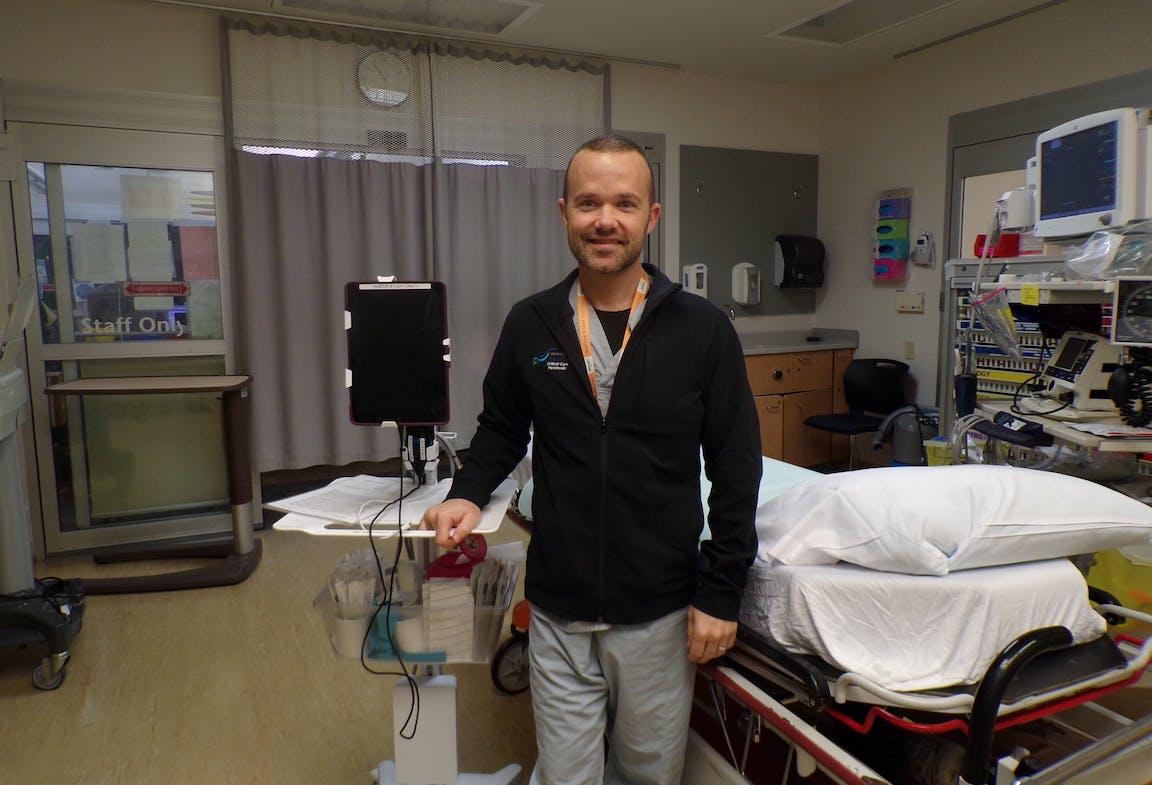
QEII critical care paramedic (CCP) and young researcher, Ryan Fitzpatrick, hopes to make IV access a more positive experience through a 12-month study aimed at assessing the success rates of intravenous cannulation. Ryan recently received a $5,000 to conduct his research through the QEII Foundation Raymond L. Roberts Emergency Medicine Young Researcher’s Grant (EMYRG). CONTRIBUTED
Study aims to make IV insertion more positive for patients
Having to endure multiple IV pokes can be a real source of stress, discomfort and pain for some people.
QEII Health Sciences Centre critical care paramedic (CCP) and young researcher, Ryan Fitzpatrick, hopes to make IV access a more positive experience through a 12-month study aimed at assessing the success rates of intravenous cannulation with the help of a paramedic team.
“When I first started in the medical profession 20 years ago, I was horrible at starting IVs, so I wanted to find a way to make it easier and more successful and bring those number of times we poke people down,’’ shares Ryan, whose personal struggles with IV access led to his interest in the study.
Recently, he was awarded a QEII Foundation Raymond L. Roberts Emergency Medicine Young Researcher’s Grant (EMYRG) to conduct a study: Paramedics Providing Point of Care Ultrasound Cannulation (POCUS) for Difficult Intravenous Access in the Emergency Department. Cannulation is a technique in which a cannula is placed inside a vein to provide venous access for sampling of blood, administration of fluid, medications, chemotherapy, and blood products.
The study was in its first phase when Ryan applied for the grant, which consisted of observing intravenous cannulation from the paramedics in the QEII’s emergency department.
It has now entered its second phase, which involves collecting data for the next nine months.
In this phase, 16 advanced care and critical care paramedics were trained on point-of-care ultrasound using the Butterfly iQ+ in January at a QEII simulation lab using arms and other simulation models.
"We did the training course, practised for a couple of hours, and released them to do their work and collecting data every time they started an IV."
He says success rates are being tracked in order to determine such things as how many attempts it took to get venous access, the location of the IV, and the type of equipment used. Data was collected during a three-month period to get a baseline of the percentage of misses and how many times it took to be successful.
"Once a patient comes into the hospital and they’ve had two attempts at an IV and they’ve been unsuccessful, they can be entered into the study. They’ve been deemed difficult by a healthcare practitioner because they failed twice" he says.
Ryan worked for more than a year with an anesthesia resident and an ICU clinical nurse educator, who was conducting a similar project in the ICU, to develop the protocol for the study which he says is important because it was difficult for him to become good at vascular access.
"I took it personally and it was one of the things that my patients complained a lot about, so we’re all trying to find ways to improve patient care. I thought if we can decrease the number of times that we have to attempt access in our patients, it’s going to decrease the infection rates, decrease pain and discomfort, and decrease patients’ inhibitions to come to the hospital because they don’t want to be injured when they come to us.’’
Although the results of the study to date aren’t yet available, Ryan says they’re in the process of pulling the data together.
Established by the QEII Foundation in 2023 through a legacy gift from the late Raymond L. Roberts, EMYRG is open to fulltime staff at the QEII’s Charles V. Keating Emergency and Trauma Centre and provides funding to support new researchers’ contributions to emergency medicine in Canada.
The impact of grants like EMYRG is huge, says Ryan, because the research simply wouldn’t happen without them.
"Expendable money simply isn’t available in nursing or paramedicine to put into research, so without grants or funding from somewhere else, we wouldn’t be able to do it."
He’s grateful to the QEII Foundation for its support of the study which he hopes will be followed by another study next year so he can continue his quest for improved patient care.
"They’re already having a horrible day and if we can make the painful parts a little less painful, then it’s a success."